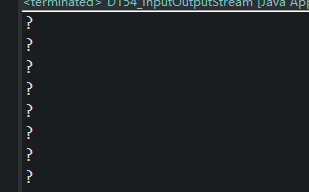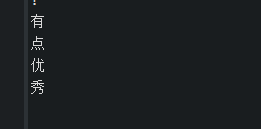一、四种方式分别举例
1.FileInputStream
InputStream is = null;
String address = "E:\\d05_gitcode\\Java\\newJava\\src\\com\\newJava\\newFile.txt";
int b;
try {
is = new FileInputStream(address);
while ((b = is.read()) != -1) {
System.out.println((char)b);
}
} catch (Exception e) {
e.printStackTrace();
} finally {
try {
is.close();
} catch (IOException e) {
e.printStackTrace();
}
}
![155.1]() 155.1
155.1
- 可以看出字符是占用至少两个字节的,我们打出的都是一堆问号,这是只打印出了一个字节,而不是字符
2.FileOutputStream
FileOutputStream fis = null;
try {
fis = new FileOutputStream(address);
fis.write("有点优秀".getBytes());
fis.close();
} catch (IOException e) {
e.printStackTrace();
}
- 这里利用了字符串带有函数getBytes(),返回了一个Byte数组,传入这个字节数组,下面的FileWriter就是传入的char数组
![155.2]()
3.FileReader
FileReader fr = null;
try {
fr = new FileReader(address);
while((b = fr.read()) != -1) {
System.out.println((char)b);
}
} catch (IOException e) {
e.printStackTrace();
}
![155.3]() 155.3
155.3
4.FileWriter
FileWriter fw = null;
char[] arargs = "太牛逼了".toCharArray();
try {
fw = new FileWriter(address);
fw.write(arargs, 0, arargs.length);
fw.close();
} catch (IOException e) {
e.printStackTrace();
}
![155.4]() 155.4
155.4
5.ByteArrayInputStream
try {
byte[] arr = "厉害了".getBytes(StandardCharsets.UTF_8);
InputStream is2 = new BufferedInputStream(new ByteArrayInputStream(arr));
byte[] flush = new byte[1024];
int len = 0;
while((len = is2.read(flush)) != -1) {
System.out.println(new String(flush, 0, len));
}
} catch(Exception e) {
e.printStackTrace();
}
6.ByteArrayOutputStream
try {
ByteArrayOutputStream baos = new ByteArrayOutputStream();
byte[] info = "厉害了".getBytes();
baos.write(info, 0, info.length);
byte[] dest = baos.toByteArray();
baos.close();
} catch(Exception e) {
e.printStackTrace();
}
二、源码:
- 欢迎关注微信公众号:傅里叶变换,个人账号,仅用于技术交流
![1000.0]()

![155.2]()


![1000.0]()





 浙公网安备 33010602011771号
浙公网安备 33010602011771号